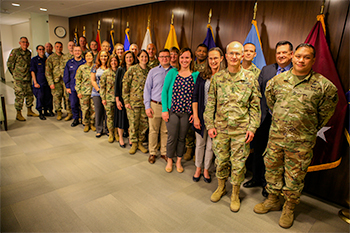 Members of the Department of Defense’s COVID-19 Operational Planning Team pose with Defense Health Agency Director Army Lt. Gen. (Dr.) Ronald J. Place (fourth from right), and Maj. Gen. (Dr.) George “Ned” Appenzeller, DHA Combat Support assistant director (far left) at Defense Health Agency Headquarters in Falls Church, Virginia, May 18 (Photo by: Mark Oswell, MHS Communication)
Members of the Department of Defense’s COVID-19 Operational Planning Team pose with Defense Health Agency Director Army Lt. Gen. (Dr.) Ronald J. Place (fourth from right), and Maj. Gen. (Dr.) George “Ned” Appenzeller, DHA Combat Support assistant director (far left) at Defense Health Agency Headquarters in Falls Church, Virginia, May 18 (Photo by: Mark Oswell, MHS Communication)
Under Garrison's leadership, the OPT set-up 10 working groups, including the Services and Combatant Commands Synchronization Working Group, Vaccine Board, Allocations and Apportionment Board, Information Technology Working Group, Logistics Working Group, Joint Planning Group, Transition Working Group and others to execute this complex operational mission for the Secretary of Defense. The OPT also provided daily vaccine operations briefs to the COVID Task Force, DOD leadership, services, the Joint Staff and Combatant Commands to ensure smooth operations and strategic communications for successful mission accomplishment to all DOD eligible personnel.
Through the working groups, the OPT developed a multi-phased approach that began with planning and then transitioned to a pilot phase when vaccines became available under Emergency Use Authorization in early December.
"After planning, we went through a pilot phase, where we tested our ability to distribute the vaccines to 16 pilot sites, 12 inside the United States and four overseas," explained Garrison. "In conjunction with DOD leadership, the Joint Staff, Health Affairs, HHS and the CDC, we also conducted a vaccine distribution table top exercise to prove our concept for vaccine distribution and discover gaps within the plan. After the pilot and exercise, we were very confident in our ability to safely provide vaccines to our worldwide population."
The "expanded distribution" phase which lasted from January to May, began after the first 16 DOD vaccination pilot sites had been issued vaccine, and distribution, storage, administration, and reporting processes were validated. During this phase the OPT developed a process to equally and proportionally allocate the limited supply of vaccine to all the DOD populations, first by using a pro-rata based upon numbers of service members in the DOD population tiers, and later, pro-rata by the number of DOD eligible persons in geographic locations surrounding the DOD vaccination sites. In May 2021, as the amount of vaccine increased, the plan transitioned to the "saturation" phase.
"In this phase, DHA gave the responsibility over to the military services to place their vaccine orders based upon their demand," Garrison said.
The "saturation" phase closely resembled standard vaccine procedures in terms of requisition, distribution and allocation.
Air Force Col. (Dr.) Tonya Rans, medical lead for the OPT and team lead for the CVIP working group, explained how a vaccination ultimately results in a stronger, more medically ready force.
"Although the preventative practices the DOD instituted – masks, physical distancing, etc. – worked very well in keeping our population safe, its benefits stopped if there were lapses in practice. Offering an FDA-authorized COVID-19 vaccine, where initial and ongoing studies continue to demonstrate its safety and efficacy, provides longer protection," Rans said. "Those that have been vaccinated can now feel more comfortable that they will remain healthy from the COVID-19 disease while in environments where it is difficult to maintain other preventative measures."
Garrison expounded upon how proud she was with what the OPT was able to accomplish: "Aside from accomplishing the secretary of defense's priorities, they were also able to deliver the required amount of the vaccine to the various combatant commands, and as support the Military Health System in administering vaccines to the 12- to 17-year-old age group, she added.
The transition from the OPT to the CVIP working group signifies the successful development and implementation of the DOD's vaccination plan, but not the completion of the mission. Garrison explained how the mission of the OPT, and now the CVIP working group, always was and continues to be to get, "shots in arms as safely and quickly as possible."
She also articulated how none of this would have been possible without an inter-service effort and the personnel in the field. "We couldn't have done this without the Joint Staff, the services and the combatant commands supporting us in ensuring that all eligible DOD populations were getting the vaccine as fast as we could get it to them," said Garrison.
"The success of the DOD COVID-19 Vaccine Distribution Operation led by Lt. Gen. Place truly shows the value of the Defense Health Agency in its role as an operational combat support agency," concluded Garrison. "This endeavor highlights DHA's ability to bring together a successful and effective team and work with the services to support the needs of the Combatant Commands, and other DOD agencies and field activities."